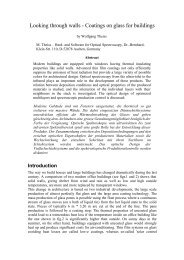CODE Tutorial 1 - W. Theiss Hard- and Software
CODE Tutorial 1 - W. Theiss Hard- and Software
CODE Tutorial 1 - W. Theiss Hard- and Software
Create successful ePaper yourself
Turn your PDF publications into a flip-book with our unique Google optimized e-Paper software.
<strong>CODE</strong> <strong>Tutorial</strong> 1 Example 1: Low-E coatings<br />
Fortunately, the addition of the oxide layers has not changed the emission in the infrared which is<br />
still low. In the next section, a more systematic <strong>and</strong> quantitative evaluation of the coating<br />
properties is done.<br />
The program configuration obtained up to now is saved as tu1_ex1_step4.wcd in the data folder<br />
of this tutorial.<br />
2.5 Coating performance<br />
Finally the low emission stack of two oxide layers embedding a metal layer is investigated a bit<br />
more quantitative. Some technical data are computed to characterize in a quantitative way what<br />
was found qualitatively up to now , by looking at the spectra <strong>and</strong> the color.<br />
Besides low emission in the infrared, expressed in the emitted power per area, we would like to<br />
have a number characterizing the transmission in the visible. A good quantity is the so-called light<br />
transmittance defined in DIN 67 504 (see <strong>CODE</strong> manual). In the list of integral quantities you<br />
find an object type called 'Light transmittance (D65)'. D65 denotes the spectral characteristics of<br />
the illuminant (see the <strong>CODE</strong> manual). Create such an item <strong>and</strong> set its spectrum to 'T Vis' <strong>and</strong><br />
'Simulation'. With Update in the list of integral quantities you get a value of 0.87 (for 30 nm<br />
thickness of the top BiOx layer , 10 nm Ag <strong>and</strong> 30 nm BiOx in the bottom layer).<br />
In a similar way you can compute the light reflectance (Object type: 'Light Reflectance'). Be<br />
sure, however, to set the spectrum to 'R Vis' <strong>and</strong> 'Simulation'.<br />
The color of the window can be specified by three color coordinates. <strong>CODE</strong> has several types<br />
of color coordinates. Here we use L*, a* <strong>and</strong> b*. Choose the object type 'Color coordinate' in<br />
the list of integral quantities <strong>and</strong> create 6 objects of this type. For three objects, set the spectrum<br />
to 'R Vis' <strong>and</strong> 'Simulation', for the others choose 'T Vis' <strong>and</strong> 'Simulation'. The default settings of<br />
L* / A / 2° can be changed by the Edit comm<strong>and</strong> or a click on the object with the right mouse<br />
19<br />
© 2012 Wolfgang <strong>Theiss</strong>



